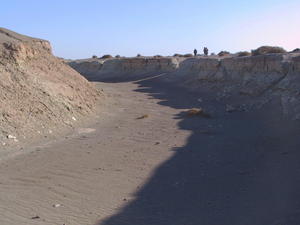Fluvial Processes 1
The river has become increasingly dry due to decrease in rainfall, Inner Mongolia
Image Credit: M. Jin, 2005
Fluvial processes may function on their own or together with other geomorphic processes. Rivers are highly dynamic systems which undergo constant fluctuations in energy and form. The river will take place to balance these two. If a change takes place, the increase of amount of energy available there will be a change in morphology. The river is very complex system with many interrelated variable. The exact response to a given variable is unpredictable. Increasing precipitation will lead to a change in the velocity. This in turn will result to changes in the cross section, change in erosion of the bed, changes in the channel shape, change in the channel roughness (texture of the bed of the channel) and change in gradient of the channel. Given one particular change in the way the energy we cannot tell how they are going to respond. The response to change is not necessarily immediate. Usually there is a time lag between a change in the energy flow and the reaction of the morphology. Sudden drastic changes may occur.
Climate change influences geomorphological processes on the hillslopes and in the streams of fluvial systems, altering both the landforms and process. The most important controlling variables of climate that change with time and greatly influences fluvial systems are precipitation and temperature. Thus the change in amount and type of precipitation will alter the rates and magnitude of weathering, erosion, transport and deposition. In turn, this will result in changes in the landforms, and processes in the whole fluvial system. Variations in sediment yield and runoff from hillslopes and in the streams can be induced by climate change, leading to changing behaviour of the streams.
 Stop and Think!
Stop and Think!
What are the effects of decreasing rainfall in humid environment?
